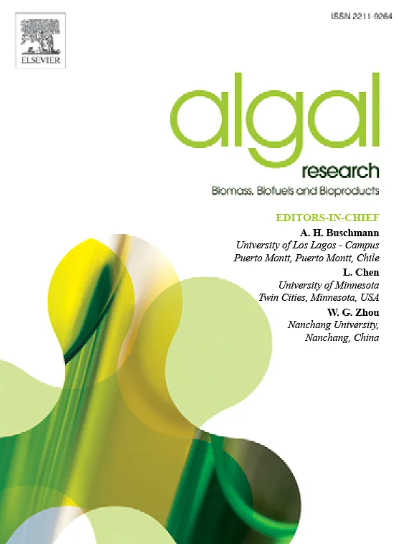微藻-细菌颗粒污泥对不同氧化铜纳米颗粒加载策略的响应机制
IF 4.6
2区 生物学
Q1 BIOTECHNOLOGY & APPLIED MICROBIOLOGY
Algal Research-Biomass Biofuels and Bioproducts
Pub Date : 2025-05-13
DOI:10.1016/j.algal.2025.104099
引用次数: 0
摘要
本研究考察了1 ~ 50 mg/L浓度的氧化铜纳米颗粒(CuO NPs)对微藻-细菌颗粒污泥(MBGS)废水处理过程的影响,比较了两种纳米颗粒添加方法:冲击负荷(SL)和逐步增加(SW)。结果表明,冲击负荷(RSL)反应器对化学需氧量(COD)和氨氮(NH3-N)的去除率更敏感,出水磷酸盐浓度呈阶梯增加(RSW)。通过扫描电子显微镜和能量色散x射线(SEM-EDX)作图可以证明,只有在CuO NP浓度≥20 mg/L时,SW方法才观察到硝酸盐氮的积累,这可能是由于纳米颗粒被困在颗粒内部。虽然在20 mg/L的CuO NP剂量下,两个反应器的总EPS水平最高,但RSW污泥中的EPS水平明显更高(RSL中的191.1 mg/g MLVSS与RSW中的218.3 mg/g MLVSS),主要是由于长期暴露导致松散结合的EPS (LB-EPS)含量增加(RSL中的75.7 mg/g MLVSS与RSW中的102.9 mg/g MLVSS)。此外,CuO NPs与EPS相互作用,结合蛋白质(PN)和多糖(PS)结构中的NH、CN、CO和C-O-C基团。本文章由计算机程序翻译,如有差异,请以英文原文为准。
Response mechanisms of microalgal-bacterial granular sludge to different loading strategies of copper oxide nanoparticles
This study investigated the effects of copper oxide nanoparticles (CuO NPs) at concentrations of 1–50 mg/L on the microalgal-bacterial granular sludge (MBGS) wastewater treatment process, comparing two nanoparticle addition methods: shock-load (SL) and stepwise (SW) increases. The results demonstrated that the chemical oxygen demand (COD) and ammonia‑nitrogen (NH3-N) removal were more sensitive in the reactor with shock-load (RSL), phosphate concentrations were higher in the effluent from the reactor with stepwise increases (RSW). Accumulation of nitrate‑nitrogen was observed only in the SW method at CuO NP concentrations ≥20 mg/L, likely due to the nanoparticles becoming entrapped within the granule interiors, as evidenced by scanning electron microscopy coupled with energy-dispersive X-ray (SEM-EDX) mapping. Although total EPS levels were highest in both reactors at 20 mg/L CuO NP dosage, the levels were significantly higher in the RSW sludge (191.1 mg/g MLVSS in RSL vs. 218.3 mg/g MLVSS in RSW), primarily due to the long-term exposure leading to increased loosely-bound EPS (LB-EPS) content (75.7 mg/g MLVSS in RSL vs. 102.9 mg/g MLVSS in RSW). Furthermore, CuO NPs interacted with EPS, binding to N![]() H, C
H, C![]() N, C
N, C![]() O, and C-O-C groups in protein (PN) and polysaccharide (PS) structures.
O, and C-O-C groups in protein (PN) and polysaccharide (PS) structures.
求助全文
通过发布文献求助,成功后即可免费获取论文全文。
去求助
来源期刊

Algal Research-Biomass Biofuels and Bioproducts
BIOTECHNOLOGY & APPLIED MICROBIOLOGY-
CiteScore
9.40
自引率
7.80%
发文量
332
期刊介绍:
Algal Research is an international phycology journal covering all areas of emerging technologies in algae biology, biomass production, cultivation, harvesting, extraction, bioproducts, biorefinery, engineering, and econometrics. Algae is defined to include cyanobacteria, microalgae, and protists and symbionts of interest in biotechnology. The journal publishes original research and reviews for the following scope: algal biology, including but not exclusive to: phylogeny, biodiversity, molecular traits, metabolic regulation, and genetic engineering, algal cultivation, e.g. phototrophic systems, heterotrophic systems, and mixotrophic systems, algal harvesting and extraction systems, biotechnology to convert algal biomass and components into biofuels and bioproducts, e.g., nutraceuticals, pharmaceuticals, animal feed, plastics, etc. algal products and their economic assessment
 求助内容:
求助内容: 应助结果提醒方式:
应助结果提醒方式:


